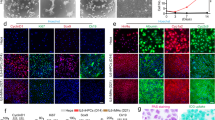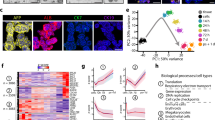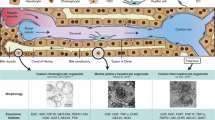Abstract
The liver overcomes damages induced by harmful substances or viral infections and allows the use of extended resection in human therapy through its remarkable ability to regenerate. The regeneration process relies on the massive proliferation of differentiated hepatocytes that exit quiescence and undergo a limited number of cell cycles to restore the hepatic mass. Many discoveries on the regulation of hepatocyte proliferation have benefited from the use of in vitro models of cultures of primary hepatocytes as well as hepatoma cells as opposed to data obtained from in vivo models of liver regeneration, such as following partial hepatectomy in rodents. In this chapter, the most pertinent in vitro models used to promote the proliferation of hepatocytes and technical procedures to synchronize their progression throughout the cell cycle are presented with the goal to investigate the regulation of the hepatocyte cell cycle and the molecular pathways regulating liver regeneration.
Access this chapter
Tax calculation will be finalised at checkout
Purchases are for personal use only
Similar content being viewed by others
References
Fausto N (2004) Liver regeneration and repair: hepatocytes, progenitor cells, and stem cells. Hepatology 39:1477–1487
Michalopoulos GK, DeFrances M (2005) Liver regeneration. Adv Biochem Eng Biotechnol 93:101–134
Avril A, Pichard V, Bralet MP et al (2004) Mature hepatocytes are the source of small hepatocyte-like progenitor cells in the retrorsine model of liver injury. J Hepatol 41:737–743
Higgins GM, Anderson RM (1931) Experimental pathology of liver: restoration of the liver of the white rat following partial surgical removal. Arch Pathol 12:186–202
Hsu JC, Bravo R, Taub R (1992) Interactions among LRF-1, JunB, c-Jun, and c-Fos define a regulatory program in the G1 phase of liver regeneration. Mol Cell Biol 12:4654–4665
Grisham JW (1962) A morphologic study of deoxyribonucleic acid synthesis and cell proliferation in regenerating rat liver: autoradiography with thymidine-H3. Cancer Res 22:842–849
Fabrikant JI (1968) The kinetics of cellular proliferation in regenerating liver. J Cell Biol 36:551–565
Albrecht JH, Hoffman JS, Kren BT et al (1993) Cyclin and cyclin-dependent kinase 1 mRNA expression in models of regenerating liver and human liver diseases. Am J Physiol 265:G857–G864
Fausto N, Campbell JS, Riehle KJ (2006) Liver regeneration. Hepatology 43:S45–S53
Cressman DE, Greenbaum LE, DeAngelis RA et al (1996) Liver failure and defective hepatocyte regeneration in interleukin-6-deficient mice. Science 274:1379–1383
Webber EM, Bruix J, Pierce RH et al (1998) Tumor necrosis factor primes hepatocytes for DNA replication in the rat. Hepatology 28:1226–1234
Seglen PO (1975) Preparation of isolated rat liver cells. Methods Cell Biol 13:29–83
Guguen-Guillouzo C, Guillouzo A (1986) Isolation of rat hepatocytes. In: Guillouzo A, Guillouzo C (eds) Isolated and cultured hepatocytes. INSERM, Paris, pp 1–12
Vanhaecke T, Rogiers V (2006) Hepatocyte cultures in drug metabolism and toxicological research and testing. Methods Mol Biol 320:209–227
Etienne PL, Baffet G, Desvergne B et al (1988) Transient expression of c-fos and constant expression of c-myc in freshly isolated and cultured normal adult rat hepatocytes. Oncogene Res 3:255–262
Loyer P, Cariou S, Glaise D et al (1996) Growth factor dependence of progression through G1 and S phases of adult rat hepatocytes in vitro: evidence of a mitogen restriction point in mid-late G1. J Biol Chem 271:11484–11492
McGowan JA, Bucher NL (1983) Pyruvate promotion of DNA synthesis in serum-free primary cultures of adult rat hepatocytes. In Vitro 19:159–166
Sawada N (1989) Hepatocytes from old rats retain responsiveness of c-myc expression to EGF in primary culture but do not enter S phase. Exp Cell Res 181:584–588
Nakamura T, Nishizawa T, Hagiya M et al (1989) Molecular cloning and expression of human hepatocyte growth factor. Nature 342:440–443
Garnier D, Loyer P, Ribault C et al (2009) Cyclin-dependent kinase 1 plays a critical role in DNA replication control during rat liver regeneration. Hepatology 50:1946–1956
Corlu A, Loyer P (2012) Regulation of the G1/S transition in hepatocytes: involvement of the cyclin-dependent kinase Cdk1 in the DNA replication. Int J Hepatol 2012:689324
McGowan JA (1986) Hepatocyte proliferation in culture. In: Guillouzo A, Guillouzo C (eds) Isolated and cultured hepatocytes. INSERM, Paris, pp 13–38
Albrecht JH, Hu MY, Cerra FB (1995) Distinct patterns of cyclin D1 regulation in models of liver regeneration and human liver. Biochem Biophys Res Commun 209:648–655
Isom HC, Secott T, Georgoff I et al (1985) Maintenance of differentiated rat hepatocytes in primary culture. Proc Natl Acad Sci U S A 82:3252–3256
Guguen-Guillouzo C, Clement B, Baffet G et al (1983) Maintenance and reversibility of active albumin secretion by adult rat hepatocytes co-cultured with another liver epithelial cell type. Exp Cell Res 143:47–54
Waxman DJ, Morrissey JJ, Naik S et al (1990) Phenobarbital induction of cytochromes P450: high-level long-term responsiveness of primary rat hepatocyte cultures to drug induction, and glucocorticoid dependence of the phenobarbital response. Biochem J 271:113–119
Bissell DM, Arenson DM, Maher JJ et al (1987) Support of cultured hepatocytes by a laminin-rich gel: evidence for a functionally significant subendothelial matrix in normal rat liver. J Clin Invest 79:801–812
Kojima T, Mitaka T, Paul DL et al (1995) Reappearance and long-term maintenance of connexin32 in proliferated adult rat hepatocytes: use of serum-free L-15 medium supplemented with EGF and DMSO. J Cell Sci 108:1347–1357
Corlu A, Ilyin G, Cariou S et al (1997) The coculture: a system for studying the regulation of liver differentiation/proliferation activity and its control. Cell Biol Toxicol 13:235–242
Hansen LK, Albrecht JH (1999) Regulation of the hepatocyte cell cycle by type I collagen matrix: role of cyclin D1. J Cell Sci 112:2971–2981
De Smet K, Loyer P, Gilot D et al (2001) Effects of epidermal growth factor on CYP inducibility by xenobiotics, DNA replication, and caspase activations in collagen I gel sandwich cultures of rat hepatocytes. Biochem Pharmacol 61:1293–1303
Corlu A, Kneip B, Lhadi C et al (1991) A plasma membrane protein is involved in cell contact-mediated regulation of tissue-specific genes in adult hepatocytes. J Cell Biol 115:505–515
Serandour AL, Loyer P, Garnier D et al (2005) TNFalpha-mediated extracellular matrix remodeling is required for multiple division cycles in rat hepatocytes. Hepatology 41:478–486
Gripon P, Rumin S, Urban S et al (2002) Infection of a human hepatoma cell line by hepatitis B virus. Proc Natl Acad Sci U S A 99:15655–15660
Cerec V, Glaise D, Garnier D et al (2007) Transdifferentiation of hepatocyte-like cells from the human hepatoma HepaRG cell line through bipotent progenitor. Hepatology 45:957–967
Aninat C, Piton A, Glaise D et al (2006) Expression of cytochrome P450, conjugating enzymes and nuclear receptors in human hepatoma HepaRG cells. Drug Metab Dispos 34:75–83
Kang LI, Mars WM, Michalopoulos GK (2012) Signals and cells involved in regulating liver regeneration. Cells 1:1261–1292
Giandomenico AR, Cerniglia GE, Biaglow JE et al (1997) The importance of sodium pyruvate in assessing damage produced by hydrogen peroxide. Free Radic Biol Med 23:426–434
Williams GM, Gunn JM (1974) Long-term cell culture of rat liver epithelial cells. Exp Cell Res 89:139–142
Williams GM, Weisburger EK, Weisburger JH (1971) Isolation and long-term cell culture of epithelial-like cells from rat liver. Exp Cell Res 69:106–112
Deschatrette J, Weiss MC (1974) Characteri-zation of differentiated and dedifferentiated clones from a rat hepatoma. Biochimie 56:1603–1611
Bailly-Maitre B, de Sousa G, Zucchini N et al (2002) Spontaneous apoptosis in primary cultures of human and rat hepatocytes: molecular mechanisms and regulation by dexamethasone. Cell Death Differ 9:945–955
Gilot D, Loyer P, Corlu A et al (2002) Liver protection from apoptosis requires both blockage of initiator caspase activities and inhibition of ASK1/JNK pathway via glutathione S-transferase regulation. J Biol Chem 77:49220–49229
Gerbal-Chaloin S, Duret C, Raulet E et al (2010) Isolation and culture of adult human liver progenitor cells: in vitro differentiation to hepatocyte-like cells. Methods Mol Biol 640:247–260
Blanc P, Etienne H, Daujat M et al (1992) Mitotic responsiveness of cultured adult human hepatocytes to epidermal growth factor, transforming growth factor alpha, and human serum. Gastroenterology 102:1340–1350
Reddy CC, Wells A, Lauffenburger DA (1996) Receptor-mediated effects on ligand availability influence relative mitogenic potencies of epidermal growth factor and transforming growth factor alpha. J Cell Physiol 166:512–522
Takatsuki K, Fujiwara K, Hayashi S et al (1990) Acceleration of DNA synthesis in post-hepatectomised regenerating liver of normal rat by insulin and glucagon. Life Sci 29:2609–2615
McMahon JB, Richards WL, del Campo AA et al (1986) Differential effects of transforming growth factor-beta on proliferation of normal and malignant rat liver epithelial cells in culture. Cancer Res 46:4665–4671
Berasain C, Garcia-Trevijano ER, Castillo J et al (2005) Amphiregulin: an early trigger of liver regeneration in mice. Gastroenterology 128:424–432
Ito N, Kawata S, Tamura S et al (1994) Heparin-binding EGF-like growth factor is a potent mitogen for rat hepatocytes. Biochem Biophys Res Commun 198:25–31
Cruise JL, Knechtle SJ, Bollinger RR et al (1987) Alpha 1-adrenergic effects and liver regeneration. Hepatology 7:1189–1194
Lesurtel M, Graf R, Aleil B et al (2006) Platelet-derived serotonin mediates liver regeneration. Science 312:104–107
Sharon Goh YP, Henderson NC, Heredia JE et al (2013) Eosinophils secrete IL-4 to facilitate liver regeneration. Proc Natl Acad Sci U S A 110:9914–9919
Author information
Authors and Affiliations
Corresponding author
Editor information
Editors and Affiliations
Rights and permissions
Copyright information
© 2015 Springer Science+Business Media New York
About this protocol
Cite this protocol
Corlu, A., Loyer, P. (2015). Culture Conditions Promoting Hepatocyte Proliferation and Cell Cycle Synchronization. In: Vinken, M., Rogiers, V. (eds) Protocols in In Vitro Hepatocyte Research. Methods in Molecular Biology, vol 1250. Humana Press, New York, NY. https://doi.org/10.1007/978-1-4939-2074-7_3
Download citation
DOI: https://doi.org/10.1007/978-1-4939-2074-7_3
Published:
Publisher Name: Humana Press, New York, NY
Print ISBN: 978-1-4939-2073-0
Online ISBN: 978-1-4939-2074-7
eBook Packages: Springer Protocols




